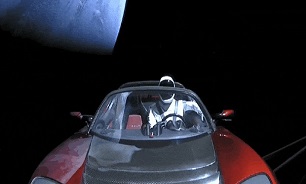There's a Chance Musk's Tesla Might Actually Return to Earth
The space Tesla has a small chance of colliding with Earth over the next million years.

khodrocar - Elon Musk’s Tesla Roadster has been set free to drift around the solar system for the next billion years, or until the solar radiation makes it disintegrate. according to a recent paper, it might not stay in space forever: a group of researchers give Starman a 6 percent chance of crashing back down to Earth sometime in the next million years.
Making exact predictions of where an object in our solar system will end up is not easy. Even over the span of a few years, tiny uncertainties in an object’s speed and exact location can have significant consequences for where it will end up. Over millions or billions of years, predicting where a tiny solar system object like a Tesla Roadster will be is mostly a matter of probabilities.
An object like the Tesla Roadster is particularly difficult to predict, because its orbit regularly brings it close to Earth, Mars, and Venus. With each pass, the gravitational forces from these planets can alter the Roadster’s trajectory. After a million years, Starman could end up anywhere.
However, with complex computer modelling, it’s possible to predict the odds that the Roadster will hit a planet in the future. According to the model, there’s a 6 percent chance that the car will impact Earth sometime in the next million years, and about a 2.5 percent chance of colliding with Venus. Over the next 3 million years, the odds of an Earth impact rise to about 10 percent.
Of course, space is a big, mostly empty place, and there’s about a 50 percent chance that the Roaster will go tens of millions of years without hitting anything. Outer space can be crushingly lonely, after all.
Making exact predictions of where an object in our solar system will end up is not easy. Even over the span of a few years, tiny uncertainties in an object’s speed and exact location can have significant consequences for where it will end up. Over millions or billions of years, predicting where a tiny solar system object like a Tesla Roadster will be is mostly a matter of probabilities.
An object like the Tesla Roadster is particularly difficult to predict, because its orbit regularly brings it close to Earth, Mars, and Venus. With each pass, the gravitational forces from these planets can alter the Roadster’s trajectory. After a million years, Starman could end up anywhere.
However, with complex computer modelling, it’s possible to predict the odds that the Roadster will hit a planet in the future. According to the model, there’s a 6 percent chance that the car will impact Earth sometime in the next million years, and about a 2.5 percent chance of colliding with Venus. Over the next 3 million years, the odds of an Earth impact rise to about 10 percent.
Of course, space is a big, mostly empty place, and there’s about a 50 percent chance that the Roaster will go tens of millions of years without hitting anything. Outer space can be crushingly lonely, after all.
Latest News


